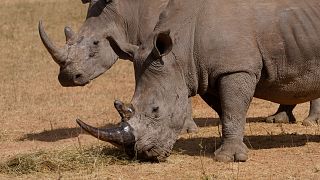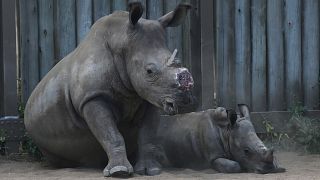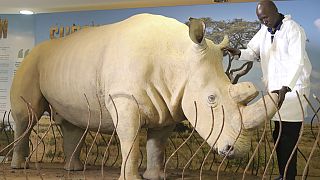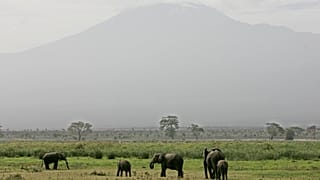Kenya
In the golden grasslands of Meru County, Kenya, a team of conservationists closes in on a white rhino.
It’s a fast, focused operation.
Rhinos are darted from above, sedated safely, then surrounded. An army of vets and rangers from the Lewa Wildlife Conservancy and the Kenya Wildlife Service then move in swiftly.
There’s a narrow window to act. With precision, they cut a small triangle from the rhino’s ear.
Each shape, each notch, forms a unique code - a kind of fingerprint that will help track and monitor this individual for life. Termed 'ear notching', it's a crucial tool in Kenya’s long fight to save its rhinos.
Dominic Maringa, Head of Conservation and Wildlife at Lewa Conservancy says: “We carry out this rhino notching exercise after every two years purposely to make sure we are able to identify individual rhinos by their numbers. Here the calving (breeding) of rhinos is very high and therefore the population is coming up as soon as possible because of the kind of the ecosystem support to the rhino population is very viable.”
Once critically endangered, Kenya’s rhinos are now making a cautious comeback. In the 1970s, poaching decimated populations. Tens of thousands were wiped out for their horns. But a new era of protection has changed the story.
Next to the "ear notching" initiative, Kenya has also managed to reduce poaching incidents through the use of technology such as thermal cameras, with which rangers can more easily detect poachers at night.
Phillip Muruthi, Vice President of Africa Wildlife Foundation says: “By the 1970s we had around 20,000 black rhinos; the eastern black rhino. Right now if you go back to the 1980s, due to poaching, around 400 rhinos or so were left by 1985. Kenya took the bold step of recovering its rhino population including building of sanctuaries, securing those which were already roaming and by last year, after many concerted efforts, Kenya achieved its key landmark of 1,000 black rhino. So we have about 1,000 eastern black rhinos, about 1,000 southern white rhinos and 2 or 3 northern white rhinos. So in total around 2,100 rhinos live in Kenya.”
In 2020, the country recorded 0 poaching incidents, and two reserves have counted no rhinos poached since 2017 and 2023 respectively. This has helped rhino populations recover considerably.
Muruthi continues: “The smaller the population of a species that we are managing, you will do what we call biological management. So you do not want mother and son breeding, for example, because you may have genetic implications and so one of the advantages of notching and individual identification is simply to manage the population and allow them to grow faster without allowing any genetic bottlenecks. In terms of disadvantages, a mistake could occur but this is very rare.”
So far this year, 46 rhinos here have been notched, each one now a known individual, each one a small step toward a safer future. And with each ear marked and each calf born, Kenya’s rhino story turns a new page: from near extinction to cautious revival, written in scars, science and determined stewardship.












01:58
Report finds that plastic pellets called nurdles are swamping the world
00:53
San Diego Zoo Welcomes Rare Fossa Triplets
Go to video
Sierra Leone chimpanzee sanctuary reopens after securing forest protection
Go to video
Science mission finds glimmer of hope for marine biodiversity in ocean depths off Comoros
01:02
Cotswold park welcomes Markus, a rare white rhino calf
02:20
Plastic bottles and food wrappers hit the runway in Lagos “trashion” show